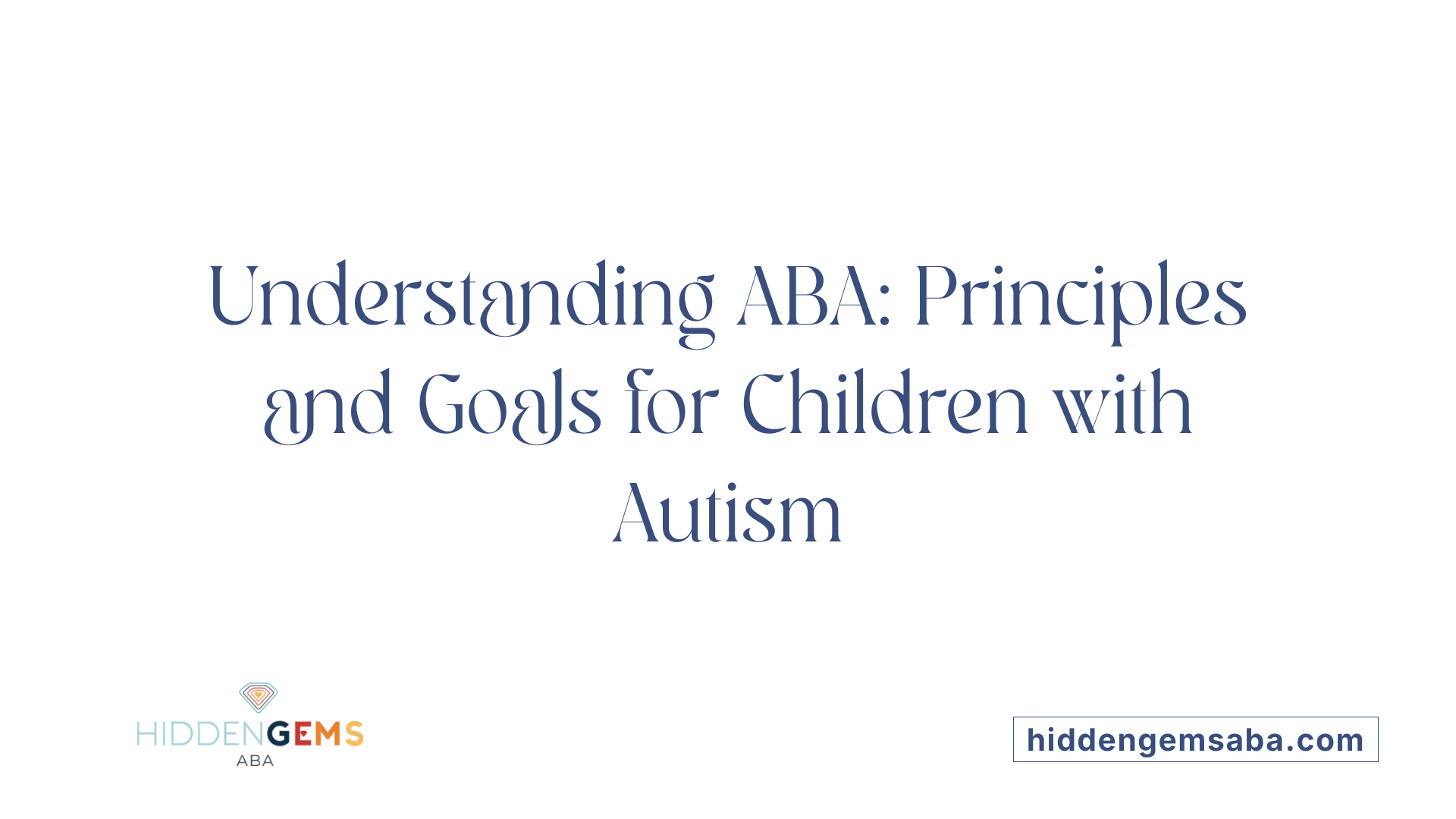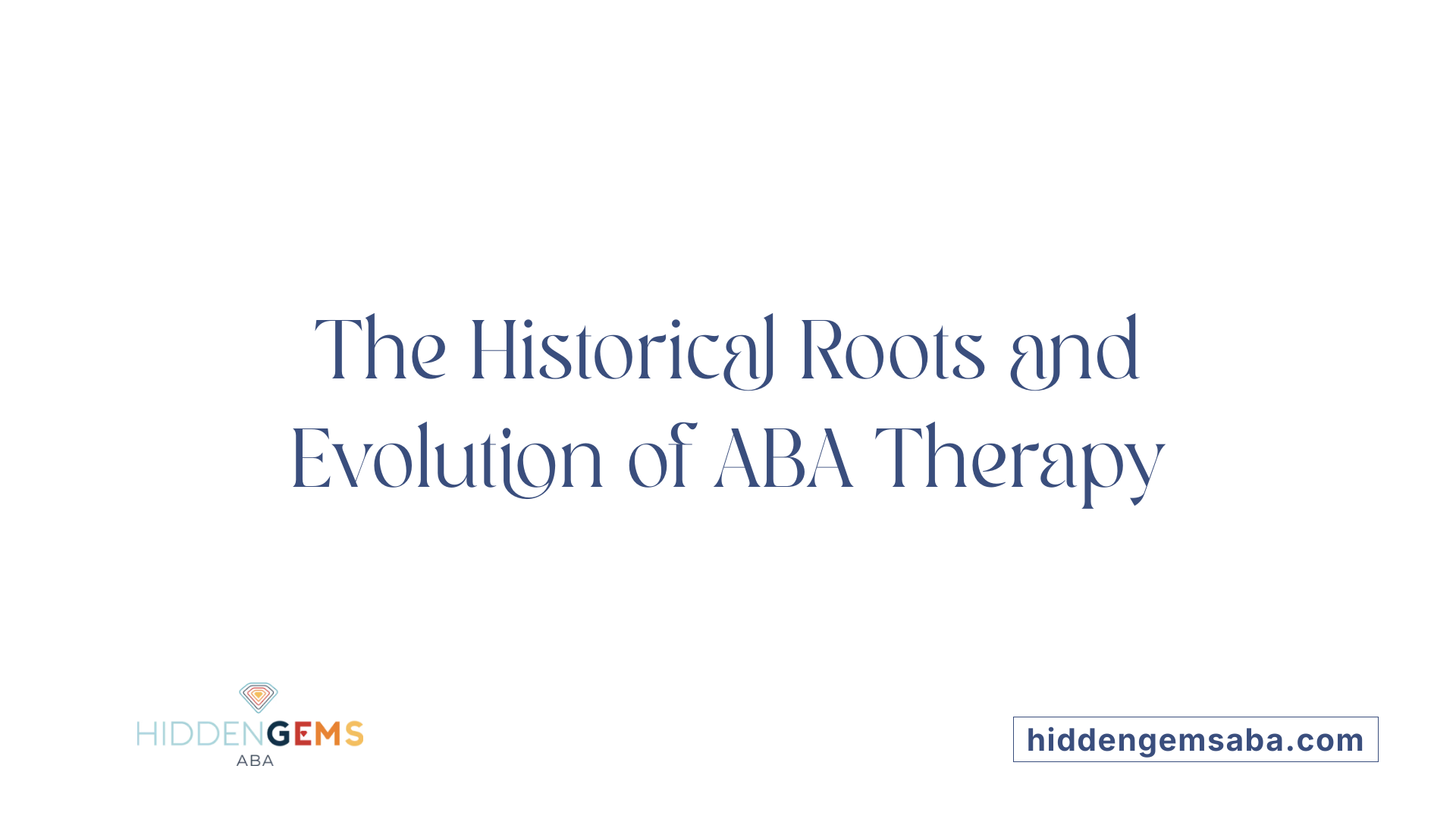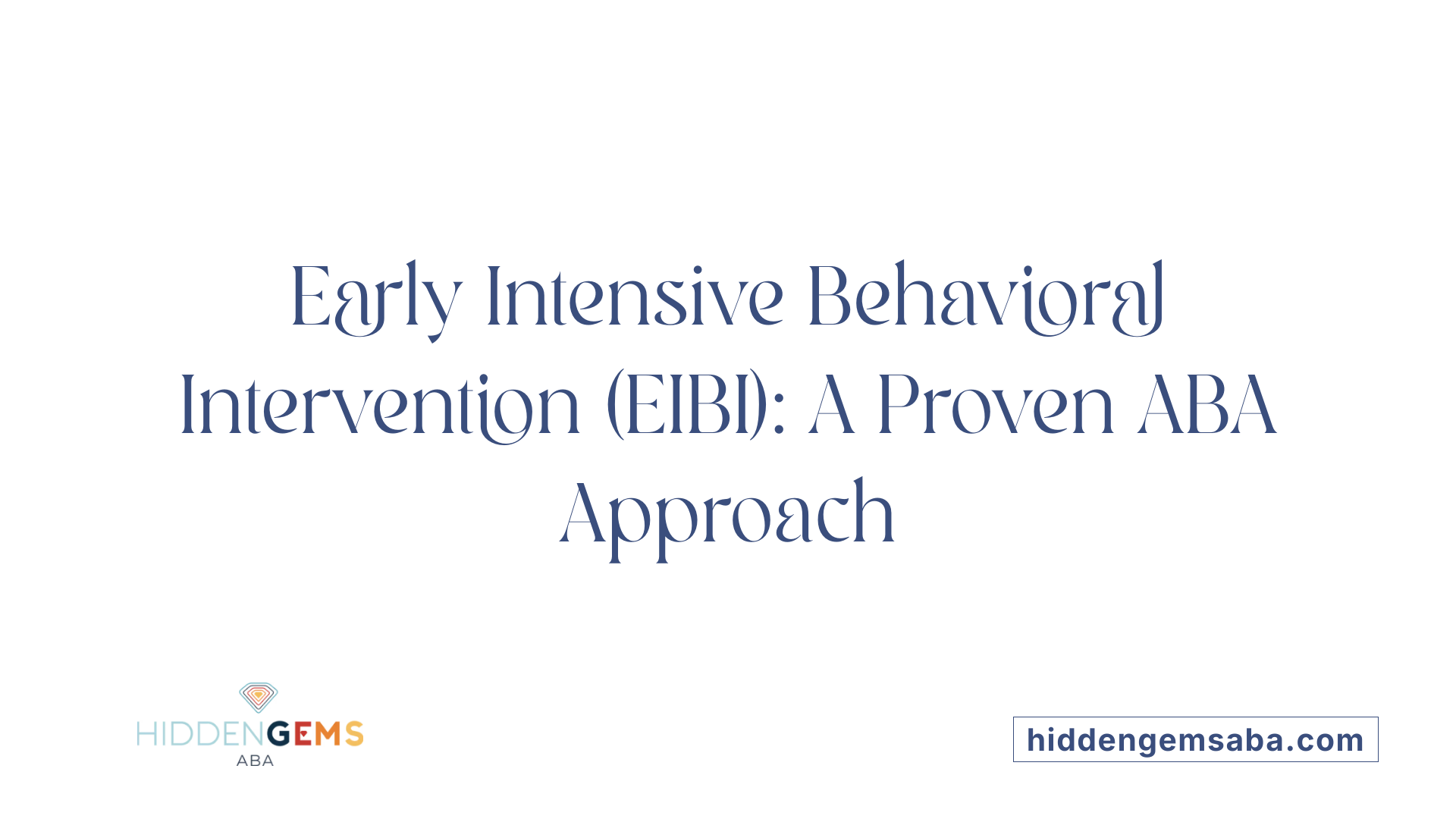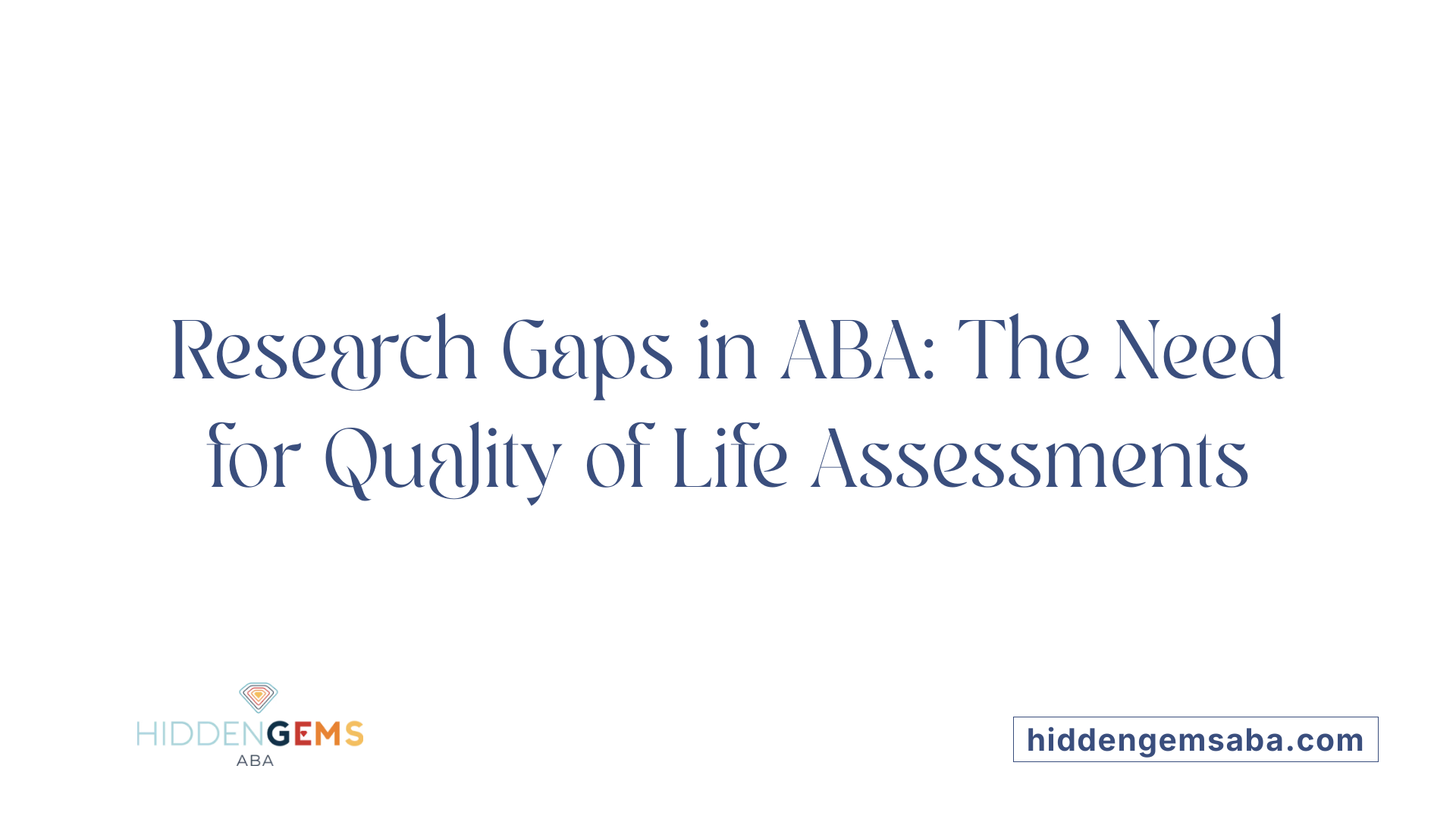Understanding ABA Therapy and Its Role in Autism Support
Applied Behavior Analysis (ABA) therapy represents a cornerstone in treating autism spectrum disorder (ASD), focusing on modifying behaviors to foster developmental progress. Rooted in behavioral science principles articulated by B.F. Skinner, ABA employs structured, evidence-based methods to enhance communication, social skills, and adaptive functioning in children with autism. This article explores ABA's impact on behavioral development, examining clinical outcomes, various treatment approaches, parent involvement, and the scope of scientific research validating its effectiveness.
Fundamentals of ABA Therapy: Principles and Objectives

What is Applied Behavior Analysis (ABA)?
Applied Behavior Analysis (ABA) is a therapeutic approach grounded in the science of learning and behavior. Developed from behavioral learning principles and operant conditioning, ABA aims to understand how behavior works and is influenced by the environment. This therapy has been applied since the 1970s to support children with autism spectrum disorder (ASD).
Behavioral Learning Principles and Operant Conditioning
ABA primarily uses operant conditioning—where behaviors are shaped by consequences. Positive reinforcement is central, rewarding desired behaviors to encourage their repetition. The 'A-B-C' model (antecedent, behavior, consequence) guides intervention, helping tailor strategies to increase functional behaviors and reduce those that hinder progress.
Focus and Goals of ABA Therapy for Children with Autism
The therapy focuses on increasing helpful and functional behaviors while decreasing harmful or problem behaviors in children with ASD. Goals include improving communication skills, social interaction, attention, memory, academic performance, and self-care abilities. ABA programs are individualized and often use structured techniques such as Discrete Trial Training (DTT) and naturalistic methods like Pivotal Response Treatment (PRT), adapting to each child's unique needs.
Personalization and Evidence-Based Methods
Assessment and goal-setting in ABA involve detailed skills analysis and program design, regularly monitored and adjusted with ongoing data collection. Intensive early intervention, often involving 20–40 hours weekly, has proven effective at fostering cognitive, language, social, and daily living skills, promoting greater independence and quality of life.
ABA therapy can be delivered in various settings—home, school, or community—and by qualified professionals or trained parents, expanding access while maintaining effectiveness.
Origins and Evolution: The Development of ABA Therapy for Autism

Historical background
Applied Behavior Analysis (ABA) is a therapeutic approach grounded in behavioral learning principles, particularly operant conditioning. It was developed based on the work of B.F. Skinner, a prominent psychologist whose research in the mid-20th century established foundational concepts guiding behaviors through reinforcement and stimulus control.
B.F. Skinner's role
Skinner's operant conditioning framework, which emphasizes modifying behavior by systematically applying consequences such as positive reinforcement, laid the groundwork for ABA. This science of learning provided a structured way to understand and influence behaviors, applying techniques like the ABCs—antecedent, behavior, and consequence—to tailor interventions.
UCLA Young Autism Project
The UCLA Young Autism Project was a pioneering study in the 1970s that marked the first major application of ABA techniques to children with Autism Spectrum Disorder (ASD). This intensive treatment program demonstrated significant positive outcomes; in fact, 47% of participating children achieved normal intellectual functioning after undergoing prolonged ABA therapy. These findings underscored ABA’s potential for meaningful developmental improvements in cognition and language.
Early application of ABA in ASD treatment
Following the UCLA initiative, Early Intensive Behavioral Intervention (EIBI) became a comprehensive ABA model targeting children under five years old. EIBI involves 20 to 40 hours per week of individualized therapy over multiple years. This early and intensive application of ABA has been shown to produce improvements not only in cognitive functioning but also in social and communication skills, marking a transformative approach to ASD treatment that continues to evolve today.
Early Intensive Behavioral Intervention (EIBI): A Comprehensive ABA Model

What is the EIBI Model?
Early Intensive Behavioral Intervention (EIBI) is a comprehensive approach based on Applied Behavior Analysis (ABA) designed specifically for young children diagnosed with Autism Spectrum Disorder (ASD). It uses structured, evidence-based techniques founded on behavioral learning principles to promote skill development across various domains.
Who is EIBI Targeted For?
EIBI is primarily targeted at children under the age of 5. Early intervention during this critical developmental window aims to mitigate the long-term impacts of ASD by fostering foundational skills at an early stage.
How Intensive and How Long are the Sessions?
EIBI involves highly intensive therapy sessions, typically ranging from 20 to 40 hours per week. This treatment is delivered over multiple years to maximize developmental gains. The intensity reflects the structured nature and breadth of skills addressed, including cognition, language, and social abilities.
What Outcomes Does EIBI Improve?
Research consistently shows that children undergoing EIBI experience significant improvements, notably in:
- Cognition: Enhanced intellectual functioning and problem-solving abilities.
- Language: Gains in both expressive and receptive communication skills.
- Social Skills: Better social engagement and adaptability.
One foundational study, the UCLA Young Autism Project, reported remarkable results, with nearly half of participants achieving normal intellectual functioning following intensive EIBI treatment, emphasizing its effectiveness.
Overall, EIBI stands as a robust, scientifically supported ABA-based model facilitating meaningful progress in young children with autism.
Empirical Evidence: Meta-Analyses on ABA’s Effectiveness

What Do Meta-Analyses Reveal About ABA’s Impact?
Meta-analyses, which combine data from multiple studies, provide strong empirical evidence supporting Applied Behavior Analysis (ABA) as an effective intervention for children with Autism Spectrum Disorder (ASD). One significant meta-analysis of 29 studies highlights that ABA programs produce moderate to large improvements across several developmental domains.
How Effective Is ABA in Enhancing Language, Social, and Intellectual Functioning?
ABA interventions demonstrate substantial effect sizes in critical areas:
- Language Development: Effect sizes of 0.650 for overall language, 0.742 for receptive language, and 0.597 for expressive language show meaningful gains.
- Social Functioning: Improvement in socialization skills has an effect size of 0.444, indicating positive changes in social interactions.
- Intellectual Functioning: Cognitive abilities and IQ scores, including those measured by non-verbal tests, improve with effect sizes ranging from 0.463 to 0.740.
These results affirm that early and sustained ABA therapy leads to enhanced communication, intellectual development, and social capacities in children with ASD.
What Is the Impact of ABA on Daily Living Skills and Problem Behaviors?
While ABA markedly improves many areas, the effect size related to daily living skills is smaller (0.138), suggesting more moderate benefits in this domain. However, ABA also effectively reduces problem behaviors, contributing to better adaptive functioning and increased independence.
Overall, meta-analytic evidence substantiates ABA as a powerful and empirically supported approach to improving the core challenges faced by children with autism, particularly when interventions begin early and are delivered intensively over time.
ABA Techniques: Overview and Comparative Effectiveness
What are the Common ABA Techniques?
Applied Behavior Analysis (ABA) incorporates several methods designed to enhance learning and behavior in children with ASD. Among the most widely used techniques are Discrete Trial Training (DTT), Pivotal Response Treatment (PRT), Natural Environment Training (NET), and Functional Communication Training (FCT).
Discrete Trial Training (DTT) breaks down skills into small, manageable tasks, teaching them systematically and repeatedly. It uses repeated stimulus presentations (mass trials) to elicit correct responses, supporting improvements in cognitive, language, and social skills.
Pivotal Response Treatment (PRT) targets pivotal areas such as motivation and response to multiple cues, aiming to produce broad improvements in communication and social behaviors.
Natural Environment Training (NET) emphasizes teaching skills in natural, everyday contexts, tapping into the child's interests to boost motivation and generalize learning.
Functional Communication Training (FCT) focuses on replacing challenging behaviors with effective communication strategies, thereby improving social interaction.
How Do These ABA Techniques Compare?
Comparative research indicates varied findings: about half of the studies report one technique being more effective than another. These differences often hinge on factors like reinforcement schedules (the timing and pattern of rewards), prompting methods (ways to guide or encourage correct responses), and modes of program delivery (e.g., clinician-led or parent-led).
Reinforcement schedules in ABA are tailored to encourage desirable behaviors effectively, balancing immediate and delayed rewards. Prompting strategies range from physical to verbal cues, gradually reducing support to foster independence.
While DTT provides structured learning, NET's naturalistic approach often enhances generalization of skills. PRT's focus on motivation may increase engagement, and FCT is especially effective for managing problem behaviors by teaching functional replacement skills.
Thus, selecting specific ABA techniques often depends on individual child needs, treatment goals, and contextual factors. Customizing methods within a comprehensive ABA program optimizes outcomes for children with ASD.
Scientific Validation: Large-Scale Versus Small-Scale Research Studies on ABA
What Research Designs Are Commonly Used in ABA Studies?
Applied Behavior Analysis (ABA) research largely relies on small-scale case studies and single-subject designs. These approaches focus on individual participants or small groups and allow detailed observation of behavioral changes over time, making them highly suitable for tailored interventions.
How Prevalent Are Case Studies and Single-Subject Designs?
Studies indicate that the majority of ABA research falls into these two categories, with small-scale case studies and single-subject designs dominating the literature. This prevalence underscores the personalized nature of ABA treatment but also highlights limitations in generalizability to larger populations.
What Is the Availability and Significance of Randomized Controlled Trials?
Only about 4% of ABA research comprises large-scale randomized controlled trials (RCTs). Despite their rarity, these RCTs are crucial for establishing strong scientific evidence by comparing ABA interventions against control groups or alternative therapies. Their significance lies in providing more definitive and generalizable conclusions about the efficacy of ABA for children with Autism Spectrum Disorder (ASD).
Gaps in Research: Quality of Life Outcomes and ABA Therapy

Absence of QoL assessments in ABA studies
Despite the extensive research supporting the effectiveness of Applied Behavior Analysis (ABA) for autism spectrum disorder (ASD), a striking gap exists: no studies in the reviewed literature have measured the impact of ABA on the quality of life (QoL) for children with ASD. Research has predominantly focused on improvements in cognitive functioning, language, social and daily living skills, and reduction of problem behaviors, but has overlooked evaluating how these changes translate into overall wellbeing.
Importance of holistic outcome measures
Evaluating QoL is crucial because it encompasses broader aspects of an individual's life, including emotional wellbeing, social relationships, independence, and life satisfaction. Relying solely on skill acquisition and behavior change fails to capture the holistic effects of ABA treatment. Integrating QoL measures alongside traditional behavioral outcomes would provide a more comprehensive understanding of how interventions affect a child’s overall functioning and daily experiences.
Long-term impacts on wellbeing
Understanding long-term impacts on wellbeing is essential to assess whether gains in skills lead to sustained improvements in life satisfaction and interpersonal relationships. Some studies suggest that early and adequate ABA treatment can mitigate ASD’s long-term effects on wellbeing. However, without explicit QoL data, these conclusions remain incomplete. Future research should incorporate standardized QoL assessments to bridge this significant knowledge gap and better inform therapy planning and policy decisions.
Scientific Foundations of ABA: Learning and Behavioral Principles

What is Stimulus Control in ABA?
Stimulus control occurs when a behavior is triggered or inhibited by specific environmental cues. In ABA therapy, therapists carefully manipulate stimuli to teach children with ASD when and where certain behaviors should occur. This precise control helps children learn appropriate responses to different contexts.
How Does Positive Reinforcement Shape Behavior?
Positive reinforcement is a foundational strategy in ABA where desirable behaviors are rewarded to increase their frequency. For example, a child might receive praise, a toy, or a favorite activity immediately after displaying a target behavior, encouraging repetition. This technique leverages the natural learning process to build new skills effectively.
What is the Three-Term Contingency?
The three-term contingency is a core concept describing the relationship between antecedent, behavior, and consequence. It outlines that a behavior (B) occurs in response to an antecedent (A) and is followed by a consequence (C). Understanding this sequence allows therapists to develop targeted interventions by modifying antecedents and consequences to promote helpful behaviors and decrease problem behaviors.
How Does Functional Behavior Assessment Inform ABA?
Functional behavior assessment (FBA) is a systematic process used to identify the reasons behind challenging behaviors. By collecting data on antecedents and consequences, FBA helps determine the function a behavior serves (e.g., gaining attention or avoiding tasks). This insight guides the development of personalized ABA plans that address root causes rather than just symptoms.
These scientific principles—stimulus control, positive reinforcement, the three-term contingency, and functional behavior assessment—form the behavioral learning foundation of ABA therapy. They enable structured, effective interventions that foster meaningful skill acquisition and behavior change in children with autism spectrum disorder.
Discrete Trial Training (DTT): Structured Teaching for Skill Acquisition
What is the role of Discrete Trial Training (DTT) in ABA?
Discrete Trial Training (DTT) is a core component of Applied Behavior Analysis (ABA) used extensively to help children with autism acquire new skills. It offers a highly structured method of teaching by breaking down complex behaviors into small, manageable tasks that can be taught step-by-step. This systematic approach allows for clear instruction and measurable progress.
How does DTT break down complex behaviors?
DTT simplifies learning by dividing behaviors into discrete units. Each unit focuses on a specific skill or response, enabling therapists to teach one aspect of a behavior at a time. This granular focus helps in addressing complex tasks by teaching them as a series of simple, achievable steps.
What are mass trials and why are they important?
Mass trials refer to the repeated presentation of a stimulus and the prompting of a response until the correct behavior is consistently achieved. This repetition is crucial for reinforcing learning and ensuring the skill becomes firmly established in the child's repertoire.
How do repetition and reinforcement work in DTT?
Repetition in DTT provides multiple opportunities for practice, increasing the likelihood that the behavior will be mastered. Positive reinforcement — rewarding correct responses — is central to this process. By consistently rewarding desired behaviors, DTT leverages operant conditioning principles to encourage skill acquisition and promote lasting behavior change.
Naturalistic Environment Training (NET): Learning in Context
Teaching within Natural Settings
Naturalistic Environment Training (NET) is an ABA technique that focuses on teaching skills within the child's everyday environment rather than in highly structured or clinical settings. This method integrates learning moments into natural contexts, such as home, playgrounds, or classrooms, where behaviors naturally occur. By embedding instruction in real-life situations, NET fosters greater generalization and maintenance of new skills.
Motivation through Learner Interests
A distinctive feature of NET is its reliance on the learner's own interests to drive engagement and motivation. This approach utilizes preferred toys, activities, or social interactions as natural reinforcers, making learning more appealing and relevant to the child. The use of intrinsic motivators encourages active participation and can increase the child's willingness to initiate communication and social behaviors.
Advantages of NET over Structured Methods
Compared to more structured methods like Discrete Trial Training (DTT), NET offers several benefits. It naturally cultivates spontaneous language and social skills by encouraging the child to initiate and respond within meaningful interactions. The flexible and child-led nature of NET allows for personalized learning moments that adapt to the child's immediate environment and needs. Additionally, NET has been shown to improve cognitive, language, and adaptive skills effectively while fostering more authentic social exchanges.
Measuring Impact: Statistical Evidence Supporting ABA Effectiveness
Large-Scale Case Studies Demonstrate ABA Progress
A notable study involving 98 children with autism evaluated the effectiveness of ABA therapy over a one-month period. This large sample size is significant in an area often dominated by smaller case studies or single-subject designs, providing more robust data on treatment outcomes.
Use of Repeated Measures and ANOVA for Analysis
The study employed a mixed repeated measures design alongside Analysis of Variance (ANOVA), a rigorous statistical method. This approach allowed researchers to track changes within participants over time, enhancing the reliability of observed improvements in targeted behaviors.
Behavior Mastery and Monitoring Progress
Results showed statistically significant improvements in the number of mastered behaviors among children receiving ABA interventions. Continuous progress monitoring allowed precise adjustments to therapy programs, ensuring goals were met effectively.
These findings strongly support that structured, data-driven ABA interventions can lead to meaningful behavior gains, emphasizing the value of ongoing assessment and evidence-based practice in autism therapy.
ABA as Gold Standard Treatment for Autism Spectrum Disorder
What Establishes ABA as an Evidence-Based Practice for ASD?
Applied Behavior Analysis (ABA) is widely recognized as the gold standard treatment for autism spectrum disorder (ASD). Grounded in the science of learning and behavior, it harnesses behavioral principles like operant conditioning to foster meaningful improvements. This recognition stems from decades of research demonstrating its effectiveness in enhancing communication, cognition, social skills, and adaptive behaviors in children with ASD.
How Does ABA Promote Skill Acquisition Across Multiple Domains?
ABA employs various scientifically validated techniques such as positive reinforcement, discrete trial training (DTT), natural environment training (NET), and functional communication training (FCT). These approaches break down complex skills into manageable tasks and use tailored reinforcement strategies within natural settings. This structure supports mastery in diverse areas including language, social interaction, daily living skills, and problem behavior reduction.
What Positive Clinical Outcomes Are Associated with ABA?
Clinical studies, including meta-analyses of dozens of trials, show medium to large effect sizes for ABA interventions. Outcomes include increased intellectual functioning, improved expressive and receptive language, enhanced adaptive behavior, and greater socialization skills. Notably, early intensive behavioral intervention (EIBI) programs delivering 20–40 hours weekly have led nearly half of treated children to achieve normal intellectual functioning. Additionally, parent-led ABA treatments supervised by certified professionals have demonstrated significant gains, expanding access while maintaining positive clinical results.
Parent-Led ABA Therapy: Expanding Access and Effectiveness
What Training and Certification Do Parents Need for ABA Delivery?
Parents can effectively deliver ABA therapy when trained with at least 40 hours of ABA instruction. This training equips them with essential skills to implement behavioral interventions scientifically and consistently. Parent instruction often includes understanding concepts such as positive reinforcement, the three-term contingency (antecedent, behavior, consequence), and techniques like discrete trial training (DTT) to break down complex behaviors.
How Are Parent-Led ABA Programs Supervised?
Supervision by Board Certified Behavior Analysts (BCBAs) is crucial for parent-led ABA to ensure quality and effectiveness. BCBAs guide parents in designing individualized programs, conducting detailed skills assessments, and monitoring progress. Regular oversight means interventions can be adjusted based on ongoing data to optimize outcomes.
What Are the Clinical and Skill Acquisition Outcomes of Parent-Led ABA?
Research shows that parent-led ABA can significantly increase the rate of skill acquisition in children with autism spectrum disorder (ASD). Children receiving parent-led therapy demonstrate growth in communication, social skills, and adaptive behaviors. Studies indicate improvements in targeted behaviors over time, supporting parent-delivered ABA as a viable approach with positive clinical outcomes.
How Does Parent-Led ABA Help Overcome Access Barriers?
Delivering ABA through parents helps bypass common obstacles such as workforce shortages, geographic limitations, and logistical challenges. This model extends therapy access to families who might otherwise face difficulties securing intensive, clinician-delivered sessions. It empowers caregivers with tools to support their child's development continuously in natural environments, enhancing consistency and generalization of skills.
Overall, parent-led ABA therapy, with proper training and supervision, expands access to effective autism interventions and demonstrates strong potential for improving child developmental outcomes.
Comparative Studies: ABA Versus Other Autism Interventions
How does ABA compare to treatment as usual, Portage, and DIR models?
Applied Behavior Analysis (ABA) is often compared to other intervention approaches to assess its relative effectiveness for children with Autism Spectrum Disorder (ASD). Key alternatives include treatment as usual, Portage, and the Developmental, Individual-differences, Relationship-based model (DIR).
Treatment as usual typically refers to standard community or educational services without specialized behavioral interventions. Portage is a home-based early education program emphasizing developmental milestones, while DIR focuses on emotional and developmental needs fostering social interaction.
What does comparative efficacy research reveal?
Research comparing ABA with these models generally demonstrates superior or at least more consistent improvements with ABA in core domains. ABA shows meaningful gains in social communication, cognitive abilities, and adaptive behaviors more reliably than Portage, DIR, or treatment as usual.
For example, meta-analyses highlight that early and intensive ABA interventions yield medium to large effects on language, intellectual functioning, and daily skills, outperforming many other programs. However, the mixed nature of some research must be noted.
Are there mixed research results?
Indeed, while numerous studies favor ABA, some comparative research results are mixed, showing overlapping benefits between approaches or modest differences. Variability arises from differences in study designs, intervention intensity, individual child profiles, and measurement methods.
Moreover, many studies are small-scale or lack randomization, with only about 4% being large randomized controlled trials directly comparing ABA to alternative treatments. This limits firm conclusions, suggesting the need for continued rigorous investigations.
Overall, despite some mixed findings, ABA remains the most empirically supported and widely implemented intervention with substantial evidence of enhanced social, cognitive, and adaptive outcomes relative to other autism interventions.
Domains Impacted by ABA Therapy: Cognitive and Language Development
How Does ABA Affect Language Development?
ABA therapy has demonstrated significant improvements in both receptive and expressive language skills among children with autism spectrum disorder (ASD). Receptive language, which involves understanding spoken language, and expressive language, which refers to verbal communication, both benefit from structured interventions in ABA. Effect sizes reported in meta-analyses indicate moderate to large improvements, with receptive language showing effect sizes around 0.65 and expressive language reaching up to 0.74. Techniques such as Discrete Trial Training (DTT) and Natural Environment Training (NET) encourage language use in a systematic yet naturalistic manner, enhancing overall communication.
What Impact Does ABA Have on IQ and Cognitive Functions?
ABA interventions contribute to enhancing intellectual functioning in children with ASD. Studies show large effect sizes (approximately 0.74) in cognitive abilities, reflecting consistent gains in IQ measures, especially when early and intensive programs such as Early Intensive Behavioral Intervention (EIBI) are implemented. The UCLA Young Autism Project notably reported that nearly half of children receiving intensive ABA treatment achieved normal intellectual functioning. These cognitive gains are attributed to the repetitive, structured learning environment ABA provides, reinforcing skills fundamental to problem-solving and learning.
How Does ABA Improve Communication Skills?
Communication improvements extend beyond verbal ability to include broader social communication skills. ABA therapy addresses social interaction and adaptive behaviors through targeted reinforcement and behavior modification. Functional Communication Training (FCT) helps reduce problem behaviors by teaching more effective communicative methods, facilitating better interaction in daily settings. The repetitive and individualized approach found in ABA aids children in mastering these communication skills, contributing to increases in successful exchanges and social engagement.
| Domain | Effect Size | Description |
|---|---|---|
| Receptive Language | ~0.65 | Improved understanding of language via targeted ABA work. |
| Expressive Language | ~0.74 | Enhanced ability to express verbally using ABA methods. |
| Cognitive Ability | ~0.74 | Significant IQ gains from structured, intensive ABA. |
| Social Communication | 0.42–0.44 | Increased social skills and adaptive behavior outcomes. |
This evidence collectively supports the role of ABA as an effective intervention for improving both cognitive and language domains in children with ASD, leading to better communication and intellectual functioning.
Social Functioning and Adaptive Behavior Gains from ABA
How does ABA improve social skills in children with ASD?
ABA interventions have been shown to significantly enhance social functioning in children with autism spectrum disorder (ASD). Techniques such as pivotal response treatment (PRT) and naturalistic environment training (NET) focus on motivating and reinforcing social interactions. Research highlights medium to large effect sizes for improvements in social skills, including communication, socialization, and engagement with peers.
What are the measured effect sizes for adaptive behavior following ABA?
Meta-analysis data reveals that ABA fosters moderate gains in adaptive behaviors, with effect sizes ranging around 0.422 to 0.444. These adaptive behaviors encompass skills such as socialization, communication, and responsiveness to environmental cues. Such improvements help children with ASD better navigate everyday social situations.
How effective is ABA in improving daily living skills?
While ABA shows robust impacts on several developmental domains, its effect on daily living skills is more modest. Studies report a smaller effect size of approximately 0.138 for daily living skills improvement. This indicates some progress in areas such as self-care and routine management but suggests that supplementary support might be necessary to maximize gains in these practical abilities.
Overall, ABA's structured approach intensively targets social and adaptive functioning, yielding meaningful benefits that enhance children's real-world interactions and increase their independence, though daily living skills may require additional targeted interventions for substantial growth.
Functional Behavior Assessment and Targeting Problem Behaviors
Understanding Problem Behaviors
In Applied Behavior Analysis (ABA), problem behaviors are actions that interfere with learning, socialization, or daily functioning. These behaviors can include aggression, tantrums, or self-injury and often hinder skill acquisition. ABA focuses on increasing helpful behaviors and decreasing harmful ones by understanding their causes and functions.
Functional Assessment Techniques
Functional Behavior Assessment (FBA) is a core ABA technique used to identify the reasons behind problem behaviors. It involves analyzing the Antecedent-Behavior-Consequence (A-B-C) sequence to determine what triggers a behavior and what reinforces it. Methods include direct observation, interviews, and data collection, allowing therapists to develop individualized intervention plans.
Behavior Reduction Strategies
Once the function of a behavior is identified, ABA employs strategies such as positive reinforcement of alternative behaviors, teaching functional communication (Functional Communication Training, FCT), and modifying environmental triggers. Data-driven adjustments ensure interventions reduce problem behaviors while promoting adaptive skills. These approaches have been proven effective in improving social communication and daily functioning in children with ASD.
Settings and Delivery Modes of ABA Therapy
Where is ABA Therapy Provided?
ABA therapy is highly adaptable and can be delivered in multiple settings to suit the child's environment and daily life. Common settings include:
- Home: This is often the primary setting where children receive ABA interventions, allowing therapy to be integrated with everyday routines.
- School: ABA techniques support academic and social skills development within educational environments.
- Community: Therapy can extend to community settings to promote real-world skill generalization.
How is ABA Delivered?
ABA interventions can be offered through both individual and group sessions, depending on the child’s specific needs and goals. Individual therapy focuses on personalized skill acquisition, while group sessions provide social interaction opportunities.
How is ABA Customized to the Child’s Needs?
ABA programs begin with a detailed skill assessment and individualized goal setting. This ensures that interventions are tailored to each child's unique strengths and challenges. Ongoing progress monitoring allows therapists to adjust strategies to maximize effectiveness across different settings and delivery methods.
This flexibility in settings and delivery makes ABA therapy accessible and practical, increasing the likelihood of successful outcomes for children with Autism Spectrum Disorder.
Insurance and Accessibility of ABA Services
Insurance Coverage Variability
Insurance coverage for Applied Behavior Analysis (ABA) therapy can differ significantly depending on the provider and location. While some private health insurance plans offer comprehensive coverage, others may impose limitations or exclude ABA services altogether. Variability also exists in terms of session limits, approved providers, and covered ages.
Mandates in Private and Medicaid Plans
Many states have enacted mandates requiring private health insurance plans to cover ABA therapy for individuals diagnosed with autism spectrum disorder (ASD). Additionally, Medicaid programs in several states provide coverage for ABA services when deemed medically necessary. These mandates aim to improve access to essential interventions and alleviate financial barriers for families seeking treatment.
Medical Necessity Criteria
For ABA to be covered by insurance, treatment must meet specific medical necessity criteria. This involves demonstrating that the intervention is essential for improving behaviors related to ASD and that it is prescribed based on individualized assessments. Typically, professionals such as Board Certified Behavior Analysts (BCBAs) complete these assessments and develop treatment plans to justify therapy coverage.
Overall, while insurance support for ABA therapy has expanded, families may still experience challenges due to variable coverage policies and documentation requirements. Understanding these insurance aspects is crucial for accessing consistent and effective ABA services.
Assessment, Goal Setting, and Data-Driven Adjustments in ABA
Skills analysis
ABA therapy begins with a comprehensive skills analysis that identifies the child's strengths and challenges. This process involves detailed observation and assessment of behaviors across multiple domains such as communication, social interaction, cognitive skills, and daily living activities. Understanding the specific skills and behaviors allows therapists to tailor interventions effectively.
Individualized program design
Based on the skills analysis, a personalized ABA program is crafted to meet the unique needs of each child. This individualized design sets clear, achievable goals targeting critical developmental areas, such as improving language, social skills, or reducing problem behaviors. Programs incorporate various techniques like discrete trial training, naturalistic teaching, and functional communication training, ensuring the approach aligns with the child's learning style and environment.
Progress monitoring and adjustments
Continuous data collection and analysis are fundamental components of ABA. Therapists systematically track the child's responses to interventions, using measurements to determine mastery of skills and identify areas needing refinement. Regular progress monitoring allows for data-driven decisions, enabling therapists to adjust reinforcement strategies, prompts, or teaching methods to maximize effectiveness. This flexible approach ensures the therapy evolves with the child’s growth and changing needs, enhancing overall outcomes.
Future Directions: Addressing Research Gaps and Expanding ABA Impact
Why is there a need for quality of life studies in ABA research?
Despite numerous studies demonstrating improvements in cognition, language, and social skills through ABA, no research has directly assessed its impact on the quality of life (QoL) for children with ASD. Quality of life encompasses broader aspects such as well-being, emotional health, and interpersonal relationships. Addressing this gap would provide a more comprehensive understanding of how ABA influences the holistic lives of autistic individuals beyond clinical symptom reduction.
What long-term outcomes should future evaluations focus on?
Current literature mostly centers around immediate or short-term gains from ABA interventions, with many studies relying on small-scale case designs. There is a pressing need for extensive longitudinal research evaluating the sustained effects of ABA across developmental stages. These studies should examine whether initial skill improvements translate into lasting independence, adaptive functioning, and participation in community life.
How can ABA integrate holistic approaches to enhance its impact?
Future research should explore combining ABA with complementary therapies that target emotional well-being and family dynamics. Integrating parent-led treatment models and naturalistic training has shown promise in enhancing access and generalization of skills. Evaluating multi-dimensional interventions that encompass mental health, social inclusion, and quality of life will create a more person-centered ABA framework.
Addressing these research directions will broaden ABA's evidence base and strengthen its role in supporting the long-term, well-rounded development of children with ASD.
The Transformative Role of ABA Therapy in Autism Support
ABA therapy, grounded in rigorous behavioral science, remains the leading evidence-based approach to supporting children with autism. Through personalized, structured interventions emphasizing skill acquisition and behavior modification, ABA fosters meaningful developmental gains across cognitive, communication, social, and adaptive domains. Despite research limitations and gaps, particularly in quality of life measurement, existing studies underscore the therapy’s effectiveness, especially when initiated early and delivered intensively. Parental involvement further broadens ABA's accessibility, making it a versatile and impactful modality. Continued research and refinement will ensure ABA continues to evolve, enhancing outcomes and enriching the lives of children with autism and their families.
References
- Applied Behavior Analysis in Children and Youth with ...
- Impact of Applied Behavior Analysis on Autistic Children ...
- Parent-Led Applied Behavior Analysis to Impact Clinical ...
- The effectiveness of applied behavior analytic interventions ...
- Applied Behavior Analysis (ABA)
- Applied Behavior Analysis (ABA)
- The Controversy Around ABA
- Applied Behavior Analysis (ABA)
- Applied Behavior Analysis in Children and Youth with ...
- Treatment and Intervention for Autism Spectrum Disorder





